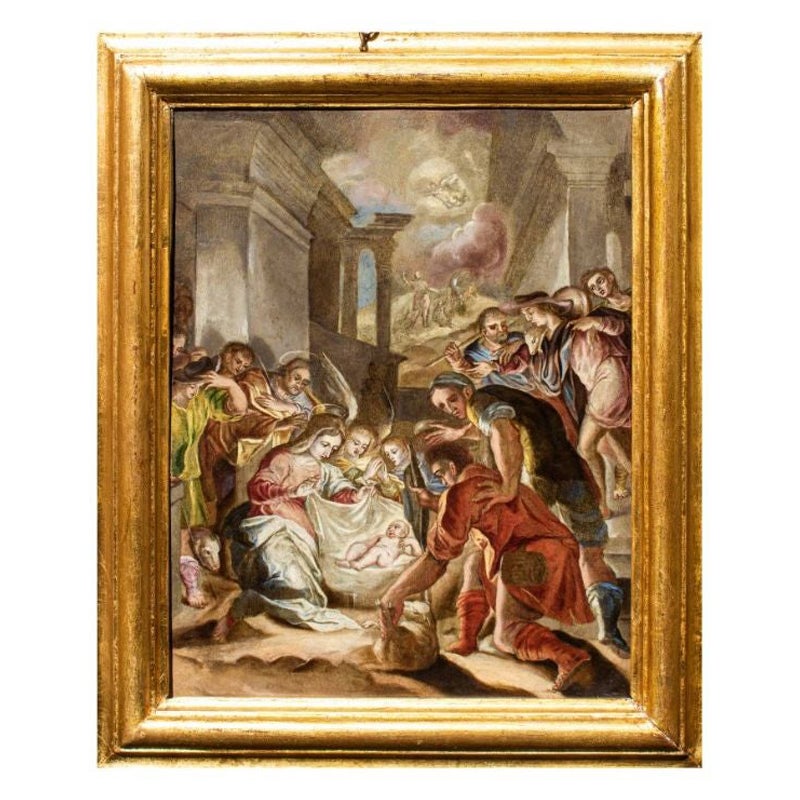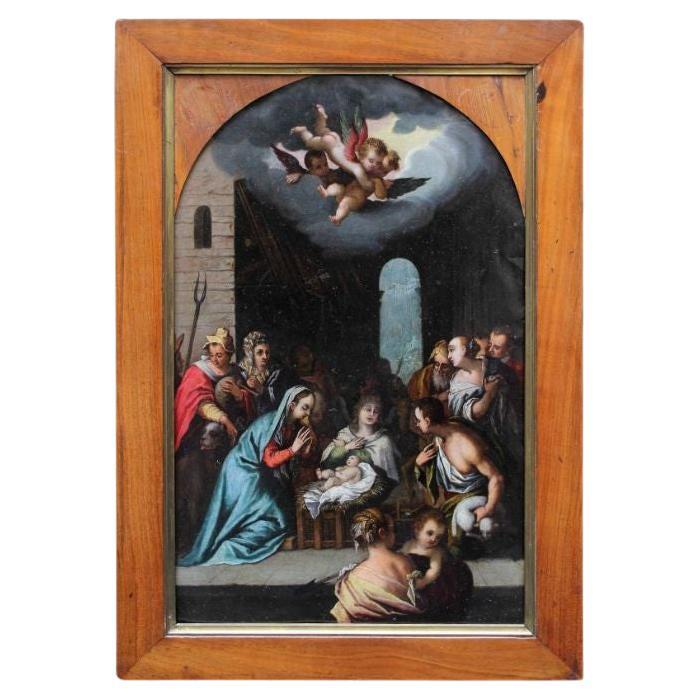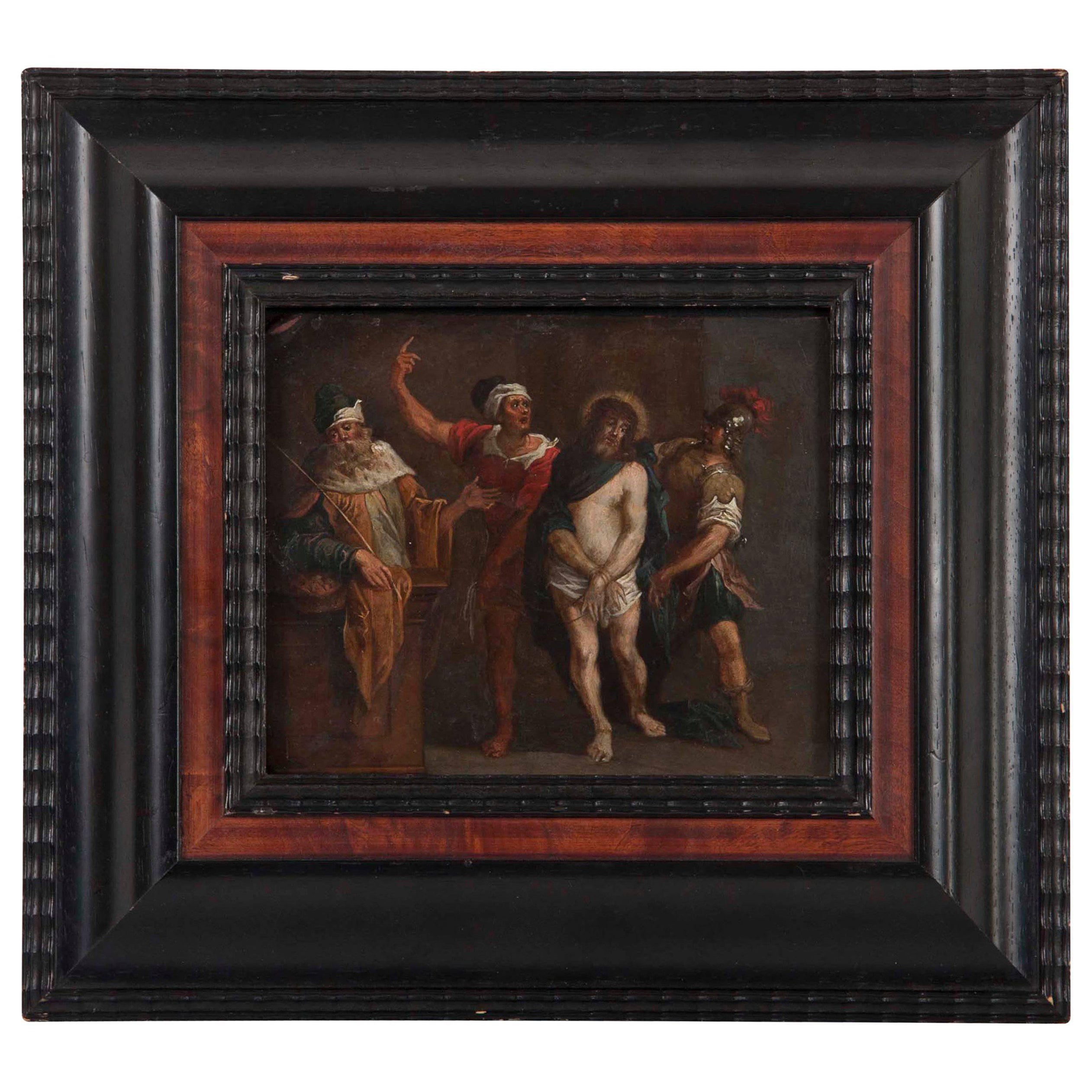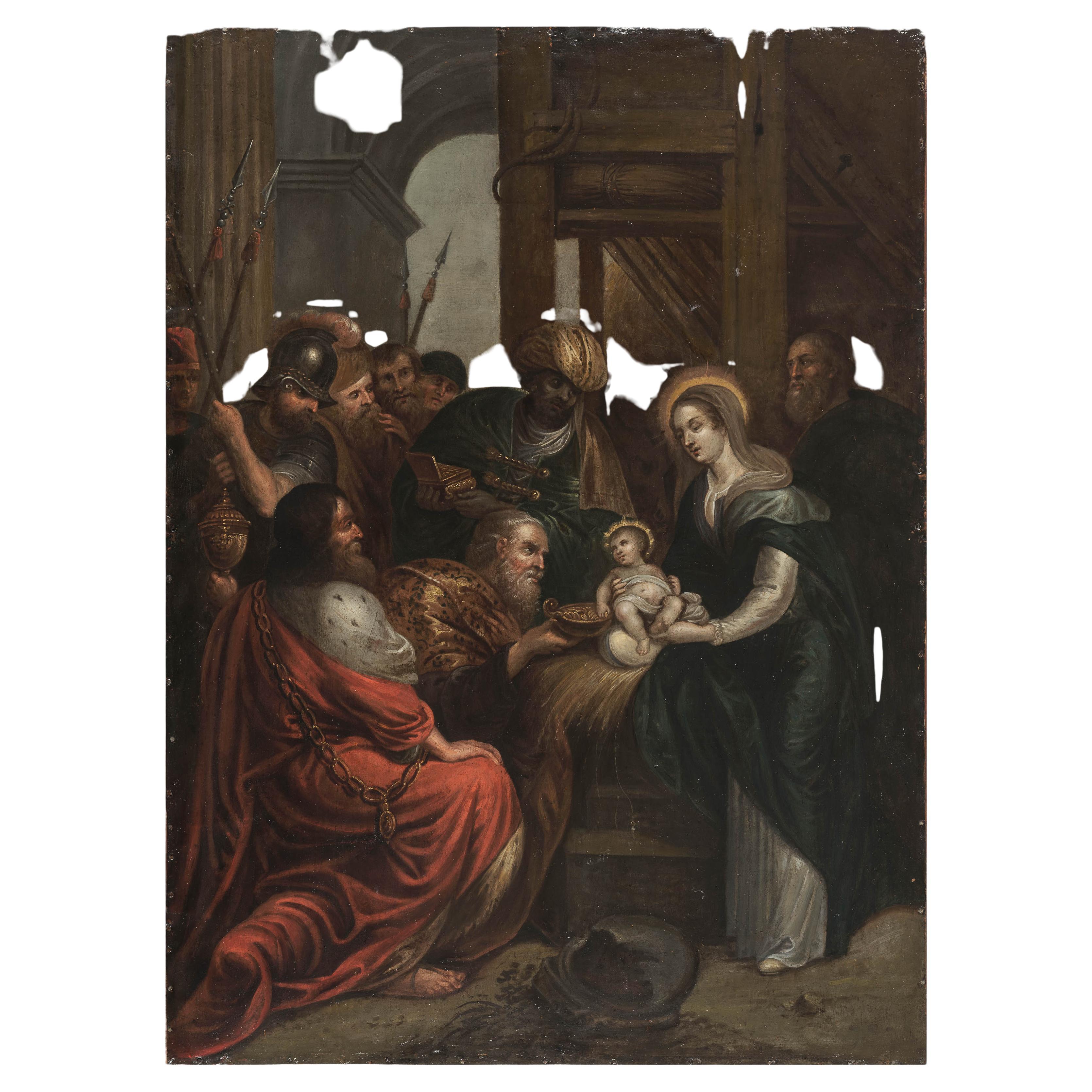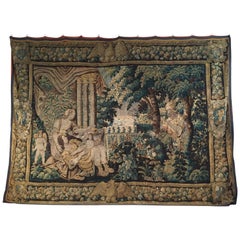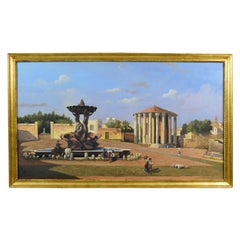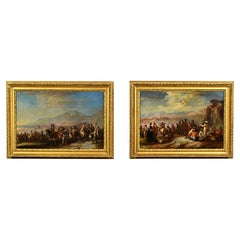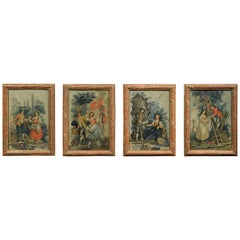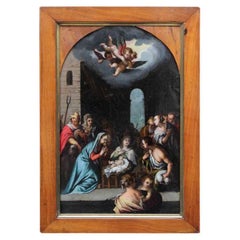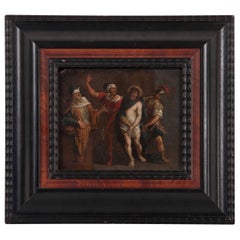Items Similar to Frans Franken III 16th Century Oil on Wood, Adoration of the Magi, Painting
Want more images or videos?
Request additional images or videos from the seller
1 of 11
Frans Franken III 16th Century Oil on Wood, Adoration of the Magi, Painting
About the Item
Frans Franken III and aid, Adoration of the Magi
Good condition
The oil painting on wood, with a gold background, depicts an Adoration of the Magi. The Magi are dressed in sumptuous silk and brocade dresses; they wear precious hats and jewelery. The richness of their garments is in contrast with the humility of the Holy Family and of the other characters who, around curious, observe the scene. The hut is simple, made of wood and straw: above it shines the Comet, symbol of the divine event. In the distance, a group of wayfarers walk along a path that is lost on the horizon, blending into the gold of the bottom.
The representation proposes a traditional iconography, in which the painter inserts some details that he lends himself to symbolic interpretations. Among these is the appearance of the Magi, who from the XIVth century differs iconographically: the wise astronomers represent the homage to Jesus of the then known parts of the world, namely Africa, Asia and Europe. To the right of the Magi, in the foreground, sits a monkey, considered a demonic creature and a symbol of lies and sin. It is depicted on the sidelines, as a defeat, next to a fragment of a classical column: ruin alludes to the end of paganism, of the old world that collapses with the advent of the new one, marked by the birth of Christ and liberation from the Original Sin. On the ruins he climbs the ivy, symbol of the immortality of the soul. The work is attributable to the workshop of the Flemish painter Frans Francken III, belonging to a prolific family of Antwerp painters who for four generations played a predominant role in local art. The comparison with a painting by Frans Francken III, preserved at the Museum of Fine Arts in Tournai, Belgium, is likely. In this work the same composition is represented, with some color variations and in which the artist describes, in the background, a glimpse of a Flemish city with houses, a bridge under which a river flows and some inhabitants. The blue sky is marked by a few clouds and some bare trees suggest the winter season.
Frans Francken III (Antwerp, 1607-1667) belongs to the Francken painter dynasty. Son of Frans Francken II and Elisabeth Placquet, he trained in his father's workshop. In 1639-40 he joined the Corporation of San Luca and in 1656, in recognition of the fortune his works received, he became its dean. His ability to paint small figures means that he is often requested by other artists to animate compositions of landscapes or interiors with staffage figures.
Frans Francken III specializes in small paintings, painting subjects both sacred and profane.
His works, characterized by the vividness of the colors, vary in the narrative richness according to the request and taste of the clients and their economic possibilities. Often overworked, the help of workshop collaborators who skillfully imitate their style is used. He has several students, including Carstian Luyckx and Jan Baptist Segaert.
We apologize for the translation errors.
Please, contact us for the italian expertise
- Creator:Frans Franken the Younger (Painter)
- Dimensions:Height: 28.75 in (73 cm)Width: 35.83 in (91 cm)Depth: 1.97 in (5 cm)
- Style:Renaissance (Of the Period)
- Materials and Techniques:
- Place of Origin:
- Period:
- Date of Manufacture:16th Century
- Condition:Please, contact us for the italian expertise.
- Seller Location:IT
- Reference Number:1stDibs: LU4405214596631
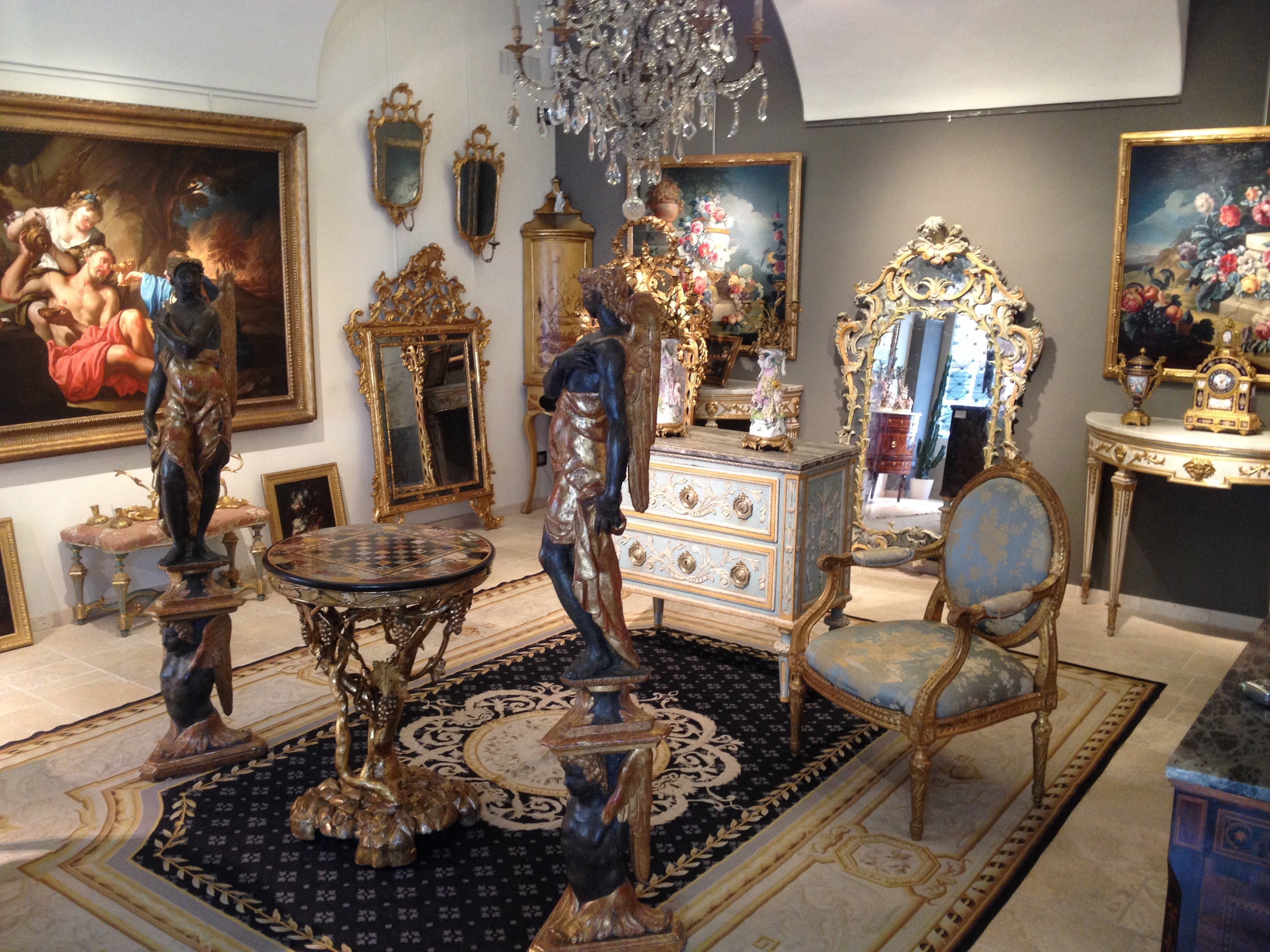
About the Seller
5.0
Platinum Seller
Premium sellers with a 4.7+ rating and 24-hour response times
Established in 1980
1stDibs seller since 2019
53 sales on 1stDibs
Typical response time: <1 hour
- ShippingRetrieving quote...Shipping from: Italy
- Return Policy
Authenticity Guarantee
In the unlikely event there’s an issue with an item’s authenticity, contact us within 1 year for a full refund. DetailsMoney-Back Guarantee
If your item is not as described, is damaged in transit, or does not arrive, contact us within 7 days for a full refund. Details24-Hour Cancellation
You have a 24-hour grace period in which to reconsider your purchase, with no questions asked.Vetted Professional Sellers
Our world-class sellers must adhere to strict standards for service and quality, maintaining the integrity of our listings.Price-Match Guarantee
If you find that a seller listed the same item for a lower price elsewhere, we’ll match it.Trusted Global Delivery
Our best-in-class carrier network provides specialized shipping options worldwide, including custom delivery.More From This Seller
View All16th Century, Flemish Storied Wood Tapestry
Located in IT
16th century, Flemish storied wood tapestry
Flanders Brussels
The beautiful and precious tapestry, of fine workmanship and made with wool yarns, was made in the 16th century in F...
Category
Antique 16th Century Belgian Renaissance Tapestries
Materials
Wool
19th Century, Oil on Canvas, Italian View of the Forum Boario of Rome
Located in IT
19th century, oil on canvas, Italian View of the forum Boario of Rome
The fine painting represents the Piazza della Bocca della Verità, located in the Ripa district, in the area of the Foro Boario, the oldest market in Rome (Italy). On the right is described the Roman Temple of about 100 B.C. wrongly called of Vesta, circular Corinthian monopter with cell of white marble ashlar and twenty fluted columns. From the 12th century it was reused as a church dedicated to Santo Stefano delle carrozze, then, in the 18th century, in Santa Maria del Sole. On the right you can see the fountain called "dei tritoni" which was built in 1717 on a design by architect Carlo Bizzaccheri. The fountain has a star-shaped bathtub, in honour of the commissioner, the Pope Clement XI...
Category
Antique Early 19th Century Italian Neoclassical Paintings
Materials
Canvas
$11,779 Sale Price
25% Off
18th Century, Italian Pair of Oil on Canvas Paintings by Francesco Simonini
By SIMONINI
Located in IT
Francesco Simonini (Parma, 16 June 1686 - Parma, 1766)
“The rest of the soldiers” and “The march of soldiers”
oil on canvas
cm 40 x 58 and 40 x 60 ; frame: h 52,5 x W 70,5 x D 6 an...
Category
Antique Early 18th Century Italian Baroque Paintings
Materials
Canvas
$27,224 Sale Price
35% Off
19th Century Four Italian Oil on Panel with Allegory of the Four Elements
Located in IT
19th century four Italian oil on panel with allegory of the four elements
Dimensions with frame: cm H 34.5 x L 25; only the table: cm H 29 x L 20.5
The funny oil on panel, by an artist active in Piedmont, in the north of Ital, in the first half of the 19th century, represent the allegory of the four elements of the Earth.
They are inspired by the group of four etching prints of circa 1730, made to a design by Rococo painter Jacopo Amigoni (Naples 1682- Paris 1752) and engraved in Venice by Joseph Wagner...
Category
Antique 19th Century Italian Rococo Paintings
Materials
Wood
18th Century, Italian Oil on Canvas Painting with Landscape with Ruins
Located in IT
18th century, Italian oil on canvas painting with landscape with ruins
Measures: only the canvas cm W 97.5 x H 108; with the frame cm W 103.5 x H 114 x D 5
The fine oil on canv...
Category
Antique 18th Century Italian Baroque Paintings
Materials
Canvas
16th Century, Pair of Italian Lacquered and Gilt Wood Sculptures Torch Holders
Located in IT
16th Century, Pair of Italian Lacquered and Gilt Wood Sculptures Torch Holders
The pair of sculptures, in finely carved wood, lacquered and gilded, was born as a torch holder, and ...
Category
Antique 16th Century Italian Renaissance Figurative Sculptures
Materials
Wood
You May Also Like
16th Century Adoration of The Shepherds Painting Oil on Copper
Located in Milan, IT
Attr. to Girolamo Siciolante known as da Sermoneta (Sermoneta, 1521 - Rome, 1575)
Adoration of the Shepherds
Oil on copper, 39 x 29.5 cm
Frame 47 x 39 cm
The refined taste, the refined poses, the definition of the anatomies, the vibrant light, allow us to identify for this painting the hand of a Mannerist painter active during the sixteenth century. In particular, the composition and stylistic research allow us to attribute the panel to Girolamo Siciolante, known as da Sermoneta (1521 - 1575). His first training took place under the guidance of Leonardo Grazia known as da Pistoia (1502 - 1548). Later he settled in Rome where he was able to see the painting of Raphael and Michelangelo from life and where he was first a pupil and then a collaborator of Perin del Vaga...
Category
Antique 16th Century Italian Paintings
Materials
Copper
16th Century Adoration of the Shepherds Painting Oil on Copper by Carnevale
By Carnevale Studio
Located in Milan, IT
Domenico Carnevale (Sassuolo, 1524 - Modena, 1579) Adoration of the Shepherds
Oil on copper, 42 x 28 cm
Frame 54 x 36 cm
Expert opinion of Prof. Emilio Negro
The painting represents the Adoration of the Shepherds, the Child in the center, next to the Madonna kneeling in prayer and an angel behind her; towards him in the foreground a woman with a child in her arms, a shepherd with a sheep on the right, a bagpiper on the left and various other male and female characters turn to him. The architectures of the background, between which a glimpse of the landscape can be glimpsed, are hidden in the upper part by the clouds, where a "celestial glory" encamps with three flying angels.
The painting shows mannerist characters that can be traced back to the second half of the sixteenth century, and can be traced back to an author from the Modena area, with stylistic references to the Bolognese Samacchini (1532 - 1577) and Passerotti (1529 - 1592). More precisely, it can be attributed to Domenico Carnevale (1524-1579), one of the most important masters of the sixteenth century active in the local area. The Carnival was formed in Emilia, his homeland, where he worked for many years. However, his works also show a clear Roman influence, dictated by a long experience in the city, during which he also dedicated himself to the restoration of the Sistine Chapel. Trained in the late-mannerist environment of Modena, he is also linked to the Parmesan Corrorese and Ferrarese Dossesque tradition; Carnival also always maintains a slight archaic sentiment in his work,
The main stylistic reference must be identified in a work similar in subject and iconographic setting, coming from the church of the Pio Istituto Orfanelle di San Geminiano di Modena, currently part of the Art Collection of the Province, attributed to the same influence as the Carnival. Another interesting comparison should be identified with A Presentation of Jesus in the Temple...
Category
Antique 16th Century Italian Paintings
Materials
Copper
Frans Franken the Younger, Ecce Homo
By Frans Franken the Younger
Located in New York, NY
Ecce Homo
by Frans Franken the Younger (Antwerp, 1581-1642)
Flemish, late 16th-early 17th century
oil on copper
Measures: H 7 in; W 8 in
Ecce Homo, "behold the man," are the Latin words used by Pontius Pilate...
Category
Antique 16th Century European Paintings
Materials
Copper
17th-Century Oil on Copper – Adoration of the Magi
Located in Madrid, ES
17th-Century Oil on Copper – Adoration of the Magi
Description:
This stunning 17th-century oil on copper depicts the Adoration of the Magi in exquisite detail. Crafted with excepti...
Category
Antique 17th Century Paintings
Materials
Copper
Flemish 17th Century Oil on Canvas Painting of the Adoration of the Magi
Located in Houston, TX
Beautiful Flemish 17th century oil on canvas painting depicting the adoration of the magi. Vivid color and wonderful quality of pa...
Category
Antique 17th Century Dutch Paintings
Materials
Canvas
17th Century Old Master Oil Painting Adoration of the Magi
Located in Nottingham, GB
In good condition
From a private collection
Free international shipping
17th Century Old Master Oil Painting Adoration of the Magi
Category
Antique 17th Century Paintings
Materials
Canvas, Paint
